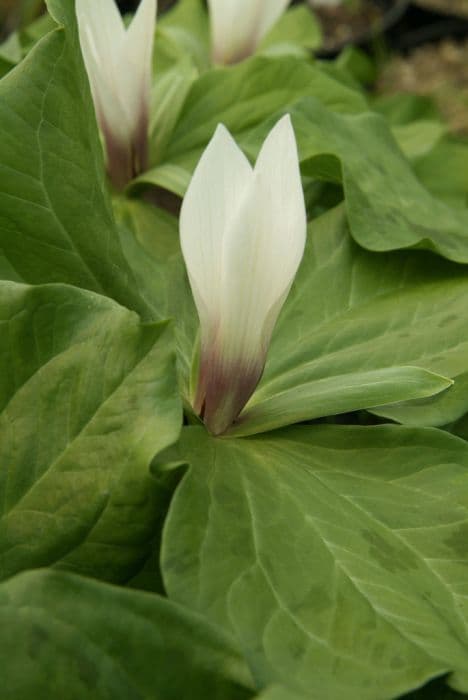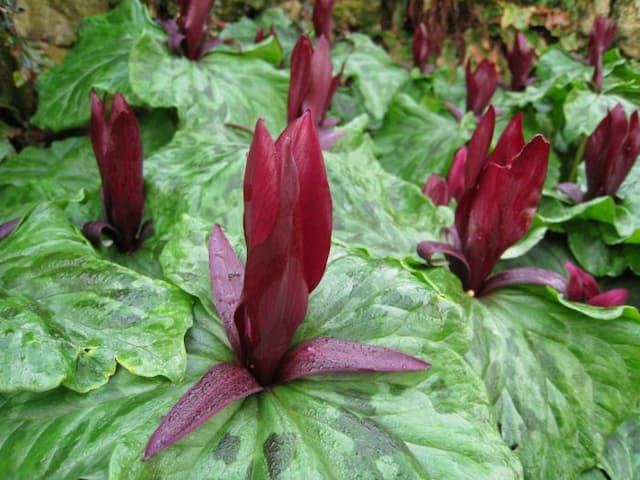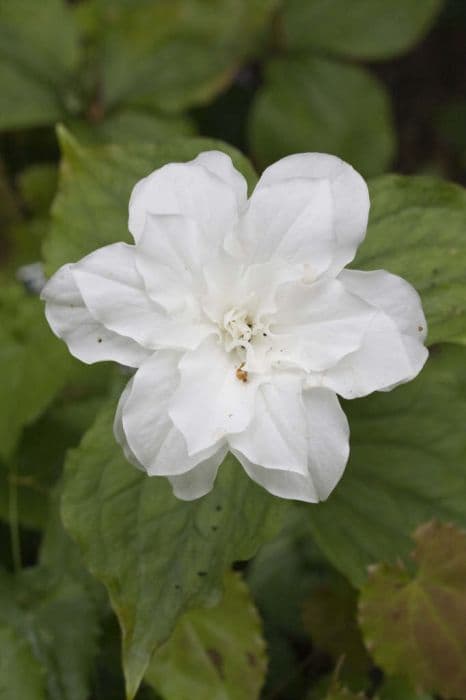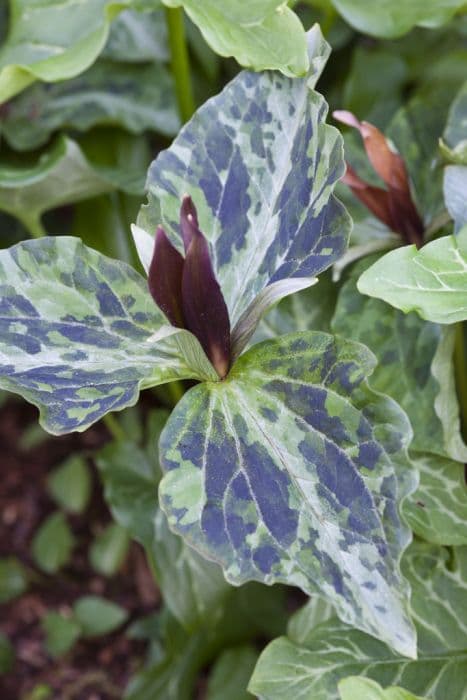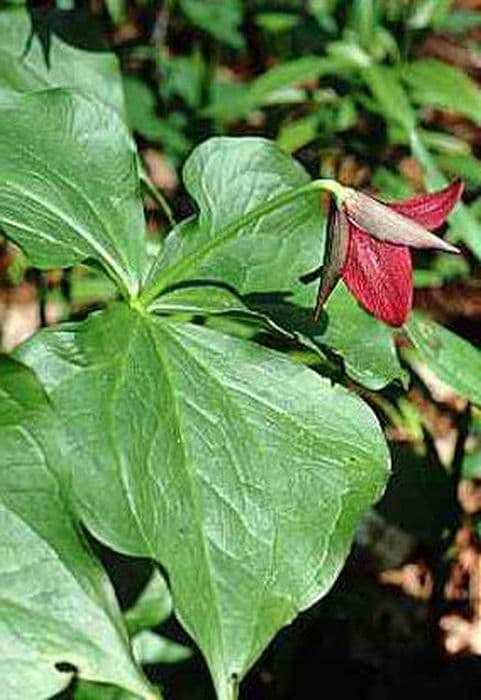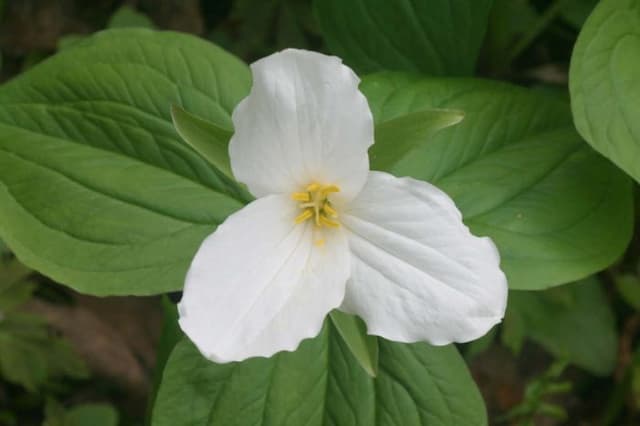White Trillium Trillium erectum f. albiflorum
ABOUT
The 'Trillium erectum f. albiflorum,' commonly known as the white-flowered wake-robin, is a charming perennial that presents itself with an exquisite trio of broad, ovate to rhombic leaves that are neatly arranged at the top of a singular, straight stem. These leaves create a lush green backdrop that truly accentuates the plant's most distinctive feature, its alluring flower. The blossom of the white-flowered wake-robin is notably composed of three stunning, white petals, which unfurl gracefully around a set of three smaller green sepals. At the heart of this star-like floral arrangement is a striking set of six yellowish stamens that encircle a prominent, ovary-like structure, all coming together to form an elegant contrast against the purity of the white petals. The visual appeal of the flower is heightened by its singular, statuesque position atop the foliage, as if it's being presented on nature's own pedestal. All these characteristics combine to make the white-flowered wake-robin a truly captivating sight when in full bloom.
About this plant
 Names
NamesFamily
Melanthiaceae
Synonyms
White Trillium, White Wake-Robin, Red Trillium, Purple Trillium, Beth Root, Stinking Benjamin
Common names
Trillium erectum var. album, Trillium rhomboideum var. album.
 Toxicity
ToxicityTo humans
The Trillium erectum, commonly known as red trillium, has components that are toxic to humans if ingested. Consuming any part of the plant can cause irritation to the mouth and digestive tract, potentially leading to nausea, vomiting, and diarrhea. There is also the possibility of experiencing dizziness and a slowed heart rate. Care should be taken to avoid ingesting parts of the red trillium plant due to these toxic effects.
To pets
Red trillium is also toxic to pets if ingested. The symptoms of poisoning in pets are similar to those in humans and can include drooling, oral irritation, vomiting, and diarrhea. In more severe cases, pets might experience a decrease in heart rate and might exhibit signs of general weakness. It is important to prevent pets from consuming any part of the red trillium plant due to its toxicity.
 Characteristics
CharacteristicsLife cycle
Perennials
Foliage type
Deciduous
Color of leaves
Green
Flower color
White
Height
1-2 feet (30-60 cm)
Spread
1 foot (30 cm)
Plant type
Herb
Hardiness zones
4
Native area
North America
Benefits
 General Benefits
General Benefits- Attracts Pollinators: Trillium erectum f. albiflorum, commonly known as White Trillium, often attracts bees and other pollinating insects, which is beneficial for the pollination of nearby plants.
- Supports Biodiversity: The presence of White Trillium in an ecosystem can increase plant diversity, which in turn supports a wider range of insects and other wildlife.
- Aesthetic Value: With its distinctive white flowers, White Trillium is often used in shade gardens and woodland plantings for its ornamental beauty, enhancing the visual appeal of natural landscapes.
- Erosion Control: The foliage and root systems of White Trillium can help stabilize soil and prevent erosion in woodland areas.
- Ecosystem Indicator: White Trillium is sometimes used as an indicator species for a healthy forest ecosystem because it thrives in undisturbed habitats.
- Native Plant Gardening: As a native species, incorporating White Trillium into gardens can help ensure the conservation of local flora and provide a sense of place.
- Source of Food for Wildlife: The seeds of White Trillium are spread by ants, and the plants can be a food source for certain mammals and birds.
 Medical Properties
Medical Properties- Antispasmodic: Trillium erectum, commonly known as red trillium or stinking Benjamin, has been traditionally used to relieve muscle spasms.
- Parturifacient: The plant has been used in traditional medicine with the belief that it can help facilitate childbirth.
- Astringent: Components of the plant have been used for their astringent properties to help reduce bleeding and diarrhea.
- Expectorant: It has been used to treat respiratory conditions by helping to clear mucus from the airways.
- Sedative: There is some historical use of Trillium erectum as a sedative to help alleviate pain and induce sleep.
 Air-purifying Qualities
Air-purifying QualitiesThis plant is not specifically known for air purifying qualities.
 Other Uses
Other Uses- Garden Ornamental: Trillium erectum f. albiflorum, commonly known as white trillium, is often used in shade gardens for its striking white flowers and tri-leaf arrangement.
- Indicator of Forest Health: As a native woodland plant, the presence of white trillium can indicate a healthy, undisturbed forest ecosystem.
- Educational Tool: White trillium is utilized in educational programs to teach about native flora and the importance of preserving natural habitats.
- Photography Subject: Due to its beauty, white trillium is a popular subject for nature photographers and botanical illustrators.
- Cultural Symbol: In some areas, the white trillium is seen as a symbol of purity and is incorporated into regional art and literature.
- Ecosystem Support: White trillium provides sustenance to native pollinators, including bees and butterflies, helping to support local biodiversity.
- Companion Planting: It can be used in companion planting in woodland gardens to create a diverse and multilayered plant community.
- Seed Dispersal Study: The plant's seeds, which are spread by ants, can be used in studies of seed dispersal mechanisms and mutualistic relationships between species.
- Natural Mulch: As the plant senesces, its leaves provide natural mulch and organic matter that enriches the forest floor.
- Dye Source: Historically, various parts of the plant have been used to create natural dyes for coloring fabrics and other materials.
Interesting Facts
 Feng Shui
Feng ShuiThe White Trillium is not used in Feng Shui practice.
 Zodiac Sign Compitability
Zodiac Sign CompitabilityThe White Trillium is not used in astrology practice.
 Plant Symbolism
Plant Symbolism- Purity - The white color of the Trillium erectum f. albiflorum, also known as White Wake-Robin, traditionally symbolizes purity and innocence.
- Elegance - With its elegant three-petaled flowers, the White Wake-Robin is often associated with gracefulness and sophistication.
- Healing - Native American tribes used trillium for medicinal purposes, which lends this plant an association with healing and recovery.
- Trinity - The three leaves and three petals of the flower can represent various trinities in religious and cultural contexts, such as the Christian Holy Trinity.
- Balance - The symmetry of the White Wake-Robin's three-part structure suggests balance and harmony in life.
- Resurrection - Blooming in the early spring, trilliums symbolize rebirth and the renewal of life, aligning with the Easter season and resurrection.
 Water
WaterThe White Bent Trillium prefers consistently moist soil, requiring watering approximately once a week. Depending on weather conditions, this may vary; during dry spells, it may need watering twice a week. The goal is to keep the soil moist but not waterlogged. A method of deep watering is recommended, which means slowly watering at the base of the plant until the soil is moist at a depth of several inches. Over a week, aim to provide the White Bent Trillium with approximately one gallon of water, ensuring that the soil has time to dry out slightly between waterings to prevent root rot.
 Light
LightThe White Bent Trillium thrives best in partial to full shade conditions. It is ideal for planting in a woodland garden or a spot that receives filtered light throughout the day. Direct sunlight should be avoided as it can scorch the leaves and diminish the plant's vitality. The best spot would be under the canopy of deciduous trees where it can receive dappled sunlight.
 Temperature
TemperatureThe White Bent Trillium does well in a range of temperatures, with optimal growth occurring between 60 to 70 degrees Fahrenheit. While it can survive brief periods of colder weather down to about 30 degrees Fahrenheit, extended exposure to temperatures below freezing can be damaging. The plant also tolerates summer heat as long as it is not excessively high and the roots are kept cool and moist.
 Pruning
PruningPruning of the White Bent Trillium is not often necessary, as the plant has a natural growth habit that typically requires little intervention. However, it is a good practice to remove dead or yellowing leaves to maintain plant health and appearance. Pruning should be done after flowering, in late spring or early summer, when the plant begins to go dormant. This will prevent stress to the plant and encourage healthy growth for the following season.
 Cleaning
CleaningAs needed
 Soil
SoilWhite trillium thrives best in a well-draining soil mix with high organic matter content, similar to a woodland setting. An ideal soil mix would be one part garden soil, one part peat moss, and one part perlite or pine bark fines to promote aeration. The soil pH should be slightly acidic to neutral, ranging from 6.0 to 7.0, to mimic their natural habitat.
 Repotting
RepottingWhite trilliums are slow-growing plants that do not need to be repotted often. In general, they should be repotted every 2-3 years or when the plant has outgrown its current container. Repotting should be done carefully to avoid damaging the roots.
 Humidity & Misting
Humidity & MistingThe white trillium prefers a humidity level that reflects its native woodland environment. While exact percentages can vary, maintaining moderate humidity around 50-60% will support the plant's health. They do not require the high humidity levels that tropical plants often need.
 Suitable locations
Suitable locationsIndoor
Keep in part-shade, ensure moist soil, cool temps.
Outdoor
Partial shade, mulch, well-drained soil, keep moist.
Hardiness zone
4-7 USDA
 Life cycle
Life cycleTrillium erectum f. albiflorum, commonly known as the white-flowered wake-robin, begins its life as a seed that germinates underground in the fall, often requiring a period of cold stratification to break dormancy. The emerging seedling relies on a mycorrhizal relationship with fungi to obtain nutrients, and it may take several years before it develops true leaves and photosynthesizes independently. Once mature, the plant forms a single stem with a whorl of three leaves and a solitary, white three-petaled flower atop, blooming in late spring to early summer. After pollination, typically by insects, the flower develops into a berry-like fruit containing seeds that are dispersed by animals. The plant then enters a period of dormancy in the winter, with the above-ground parts dying back and the energy being stored in the rhizome underground. The cycle resumes the following spring with the emergence of new growth from the rhizome, continuing the perennial cycle of the plant.
 Propogation
PropogationPropogation time
Spring to Early Summer
Trillium erectum f. albiflorum, commonly known as white-flowered wake-robin, is typically propagated by seed method, which is widely considered as the most popular means of propagating this plant. Sowing seeds should ideally occur in late summer or fall, directly following seed maturity. To start the process, seeds are scattered on the surface of a moist, well-drained seedbed, or alternatively, sown in pots with a mixture of leaf mould and loam. The key to successful germination is providing a cold stratification period; natural overwintering outdoors satisfies this requirement effectively. Once sown, patience is paramount, as seeds can take up to two years to germinate. Post-germination, seedlings usually need a few years of growth before they are sturdy enough to be transplanted to their final growing location. This slow and steady process ensures the development of a healthy root system which is vital for the survival of these woodland perennials.
